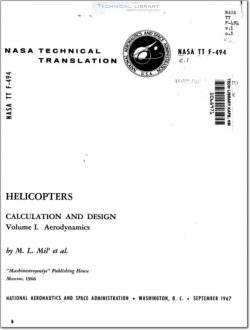NASA-TT-F-494

- Version
- 261 Downloads
- 37.27 MB File Size
- 1 File Count
- August 18, 2016 Create Date
- September 24, 2020 Last Updated
Helicopters - Calculation and Design - Vol I; Aerodynamics
Designing is always directed toward the future. However, for a better
picture of the potentialities of the future development of helicopters it is
useful to attempt to understand the basic trends of their evolution from past
experience. Naturally, we are not interested here in the prehistory of heli-
COpter construction, which we will only briefly mention, but in its history from
the time when the helicopter as a new type of aircraft became useful for practi-
cal application.
The writings of Ieonardo da Vinci going back to 1483 contained the first
mention of an apparatus with a vertical rotor, a helicOpter. The first stage of
evolution ranges from the model of a helicopter deve10ped by M.V.Lomonosov in
175A through a long series of designs, modeIS, and even fullpscale apparatus
which were not destined to rise into the air, to the construction of the world's
first helicopter which, in 1907, was able to become airborne. This four-rotor
helicopter was constructed by the French designers Breguet and Riche. In 1923,
a passenger became airborne for the first time in the USA in a helicOpter de-
signed by de Bothezat. The first world altitude record of a helicOpter of 18 m
was set in 1930 on the Italian coaxial helicopter by d'Ascanio.
In Russia, a single—rotor helicOpter was built in 1911, on the basis of
the scientific research by N.Ye.Zhukovskiy devoted to helicOpter rotors, by a
group of his students headed by B.N.Yur'yev. The configurations of this machine
represent the basic scheme of the single-rotor helicopters used widely at
present. B.N.Yur'yev was able to resume this work only in 1925. In 1932, a
group of engineers headed by A.M.Cheremukhin constructed the helicopter TsAGI
lFEA (Fig.1.l) which reached an altitude of 600 m and stayed in the air for
18 min, which — for that time — was an outstanding achievement. It suffices to
say that the official altitude record established three years later on Breguet's
new coaxial helicopter was only 180 m.
At this time there was a pause in the deveIOpment of helic0pters. A new
branch of rotary—wing aircraft came to the forefront, known as autogiros. The
idea of the autogiro, as an aircraft with a rotary wing (freely rotating air—
foil) never losing speed, occurred to the young Spanish engineer Juan de la
Cierva in the 19205. At that time, conventional aircraft whose development had
been vigorous during the years of world war I and which, by then, carried [5
armament and thus had greater wing loading were troubled by a new problem of
spin, i.e., stalling. It appeared simpler to develop a safe and sufficiently
perfected autogiro than to build a helic0pter. The rotor, freely rotating due
to the relative flow, eliminated the need for complex reduction gearing and
transmissions.
| File | Action |
|---|---|
| NASA-TT-F-494 Helicopters - Calculation and Design - Vol I; Aerodynamics.pdf | Download |
Comment On This Post